Pros and Cons of Feeding Wet By-Products
Pros and Cons of Feeding Corn Gluten Feed and Distillers Grains
By-products from both the wet and dry corn milling industries make excellent and economical feeds in balanced rations for both dairy and beef cattle. The key to feeding these products is to understand the merits and limitations of these by-products, use these feeds within the confines of balanced rations, and, most importantly, understand what you are purchasing.
The old adage” Buyer beware” is especially true when purchasing these products because several different products are sold in Kentucky and neighboring states. This article contains various questions and answers regarding feeding (1) corn gluten feed, (2) various distiller by-products, and (3) wet forms of both of these by-products.
Corn Gluten Feed
Q: How is corn gluten feed produced?
A: The wet milling process generally takes place in large mills and produces ethanol or high-fructose sweeteners for the food industry. One bushel of corn can produce enough high fructose sweetener for 375 cans of pop or soda or 2.5 gallons of ethanol for fuel. In this process, corn is steeped for 30 to 40 hours to begin the process of breaking down the kernel. Different parts of the corn kernel are used in the production of different livestock feeds. (See figure #1) For example, corn oil is extracted from the germ leaving behind corn germ meal. Corn gluten feed is made by combining approximately two-thirds of the bran with steepwater solubles condensed to the consistency of molasses. (The percentages of each fraction can vary between plants and batches within a plant.) Some mills may add corn germ meal back to the corn gluten feed depending on production practices. This product then can be dried or pressed (to remove some of the liquid) into a wet product.
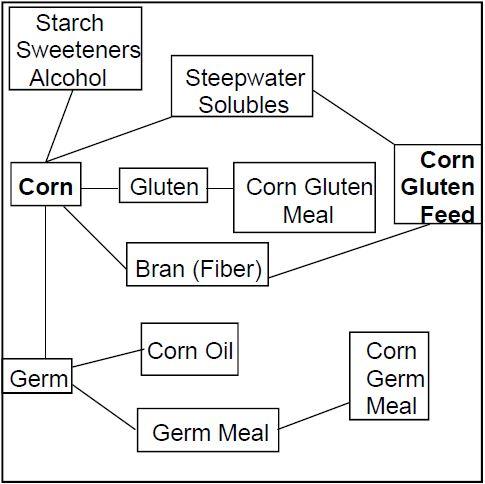
Figure 1. Wet Milling Process for corn grain (Source: Iowa State University- IBC-18 extension publication)
Q: What are the nutritional merits of feeding corn gluten feed compared to corn grain?
A: Corn gluten feed is a medium protein source (23.2% crude protein, DM basis - Dairy NASEM 2021) with low rumen undegradable protein, and is an excellent energy source. During the wet milling process, starch is fermented and resulting in a residual feed composed of highly digestible fiber (NDF fraction). Thus, corn gluten feed can be used to improve fiber digestion, especially with low quality forages, and minimize starch loads in the rumen. Corn gluten feed is higher in phosphorus and sulfur then corn grain. (Table 1) The sulfur content of corn gluten feed can vary due to manufacturing processes. Corn gluten feed is low in lysine, the first limiting amino acid for cattle, and corn gluten feed is similar in fat content to corn grain.
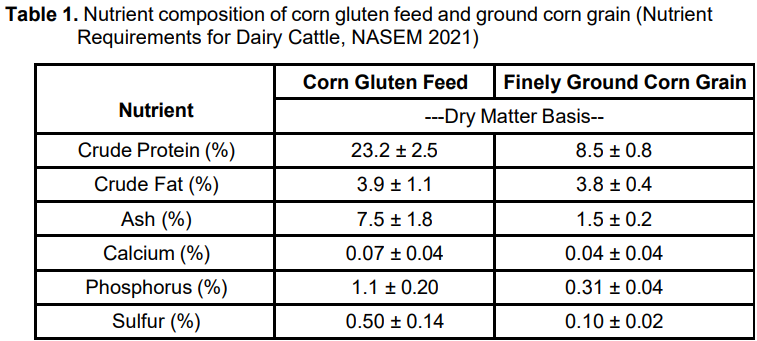
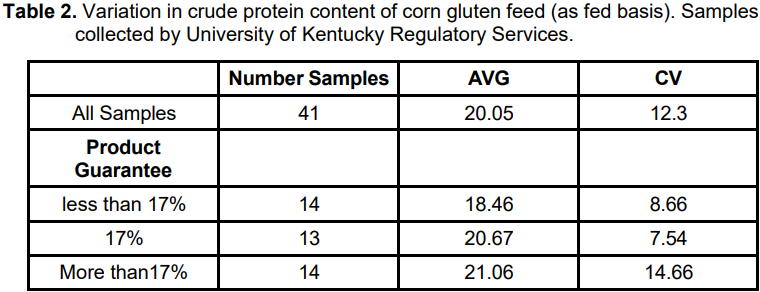
Q: How variable is the nutrient content of corn gluten feed?
A: Like many by-product feeds, the nutrient content of corn gluten feed can be highly variable. Table 2 illustrates the variation in crude protein content found in samples collected by University of Kentucky Regulatory Services. Crude protein content varied between 15.2 to 27.1 percent on an as fed basis with the greatest variation seen in corn gluten feed products guaranteed over 17% crude protein (as fed basis). This variation can be attributed to the manufacturing plant and the manner in which various waste streams are combined. Also, the amount of sulfur found in the product can vary depending on the manufacturing process. High concentrations of sulfur in the diet can result in lower amount of copper being available to cattle, thus decreasing their immune status. The bottom line is you need to test the product you are purchasing on an ongoing basis.
Q: Why is dried corn gluten feed often sold as a pellet?
A: Pelleting corn gluten feed helps reduce dust and reduces loss of product in handling and storage. Naturally dried corn gluten feed is light and fluffy and pelleting helps resolve this problem.
Q: Have university research trials seen similar or better performance when corn gluten feed is included in rations for either dairy or beef cattle?
A: When balanced rations are fed to both dairy and beef cattle, research trials at various universities have seen equal or better performance when corn gluten feed, either in the dried or wet form, is included into the ration. The key here is to feed a balanced ration for the cattle being fed this diet.
Distillers Grains and Other Co-Products
Q: How are distillers grains and other distillery co-products produced?
A: In whiskey distilleries and ethanol plants, the dry milling process is used to produce alcohol which is refined into ethanol or whiskey. Although corn is the predominant grain used, wheat, rye, barley and sorghum (milo) can be used. The name of the product reflects the predominant grain used in the fermentation process.
Corn starch, comprising approximately two thirds of the corn grain, is the primary substrate for the fermentation to produce these alcohol products. In the dry milling process, the grain is first ground, next enzymes are added to break down the starches into sugars, and then yeast is added to ferment the sugars into ethanol and carbon dioxide. This fermentation process takes 30 to 40 hours to complete.
After the ethanol has been removed, the resulting product is centrifuged to separate the solubles from the particulate matter. (Figure #2) The solubles (thin stillage or slop) can be condensed to about 30 percent dry matter to form condensed distillers solubles (CDS). This product can be sold or added back to the wet or dried distillers grains to form another product containing solubles.
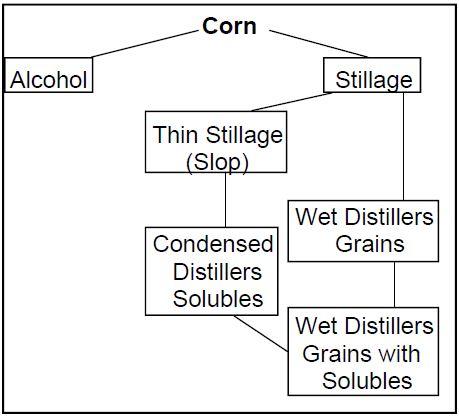
Figure 2: Dry Milling Process for Corn Grain (Source: Iowa State University - IBC-18 Extension Publication)
Q: What are the nutritional merits of feeding distillers grains with solubles as compared to corn grain?
A: The fermentation process increases three-fold the concentration of protein, fat, and fiber since the soluble carbohydrates, starches and sugars, are fermented in the dry milling process. This fermentation results in a feedstuff with a lower concentration of starch and increased digestible (NDF) fiber content. This feed can have a positive effect on rumen fermentation in properly balanced diets by improving fiber digestion in the rumen. Distillery products are good sources of methionine (often the first limiting amino acid for milk production), but are low in lysine (second or co-limiting amino acid). They are also higher in phosphorus when compared to corn grain (Table 3). Both wet and dry distillers grains are an excellent source of ruminally undegradable protein (approx. 42-47% RUP as a % CP, NASEM 2021) in diets for both dairy cattle and backgrounding beef calves.
The oil found in distiller grains with solubles is “free oil” (not inside the oil seed cells) and is high in unsaturated fatty acids. Thus, if too much is fed, the free oil can reduce fiber digestion by “coating” the fiber digesting bacteria and/or fiber particles and can result in lower milk butterfat test in dairy cows. From the positive side, a limited amount of unsaturated fatty acids may have a beneficial effect on reproduction. The fat content of distillers grains with solubles can be highly variable depending on the amount of solubles added back to the distillers grains and whether the fat has been removed.
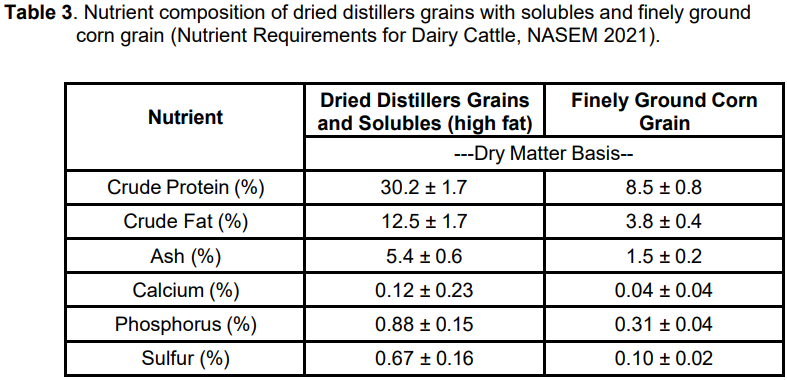
The fermentation process has been refined over the years, thus nutrient composition data collected prior to 1990 may not reflect the nutrient composition of distillers grains with and without solubles sold today.
The fermentation process not only concentrates fat, protein and fiber compared to corn grain, but also mycotoxins found in corn. When purchasing distillers, make sure that the plant screens its corn source for mycotoxins. One mycotoxin, aflatoxin is considered a human carcinogen and milk is screened routinely for aflatoxin M1. DON or vomitoxin is another mycotoxin of concern when feeding dairy cows.
Q: How variable is the nutrient content of distillers grains with solubles?
A: Like other by-product feeds, the nutrient content of distiller grains with solubles can be highly variable. A survey of 8 ethanol plants in Minnesota (5), South Dakota (2), and Nebraska (1) twice monthly for six months in late 1997, showed substantial variation in nutrient composition between and within plants. (Table 4) The largest variation between plants was seen in fat and ash content and particle size. This variation can be attributed to nutrient content of the corn crop, percentage of solubles added back to the distillers dried or wet grains, and the completeness or duration of the fermentation process. Samples collected from bourbon distilleries in 2020 also revealed large variation in nutrient content between distilleries and within the same distillery (personal communication).
Condensed distillers solubles (CDS) generally contains more fat than the solids fraction, thus the amount of CDS added back changes the fat content of the resulting product. The bottom line is you need to know what product you are purchasing, how much solubles were added back to the solids, and you need to analyze the product for its nutrient content.

Q: What livestock feeds can distilleries manufacture?
A: Tables 5 and 6 illustrate the variety of products that can potentially be produced by a distillery. The key is to know what you are actually purchasing.
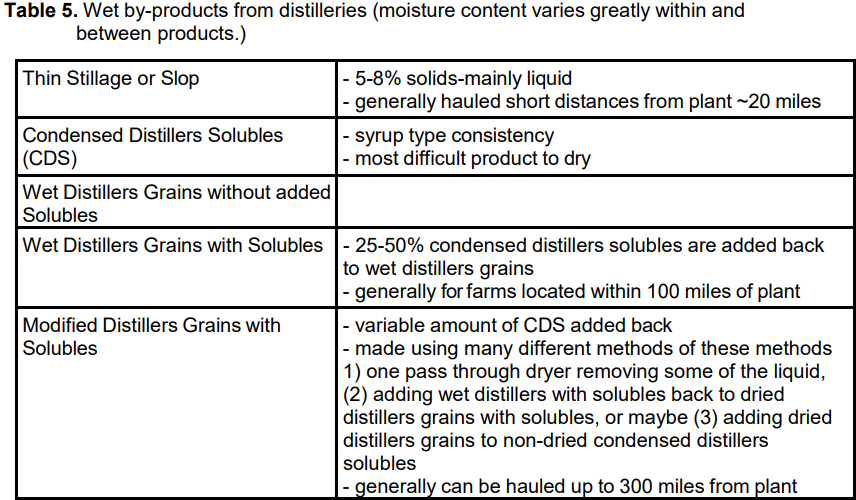

Q: Have university research trials seen similar or better performance when wet or dried distillers grains with solubles is included in rations for either dairy or beef cattle?
A: When balanced rations are fed to both dairy and beef cattle, research trials at various universities have seen equal or better performance when distillers grains with solubles, either in the dried or wet form, is included into the ration. The key here is to feed a balanced ration for the cattle being fed this diet.
Q: When feeding distiller by-products - what are the feeding recommendations for lactating dairy cows?
A: For any group of cattle, these products need to be part of a balanced ration. In addition, for dairy cows:
- Wet or dried distillers grains with solubles contains less starch than corn grain and can be used to dilute out starches found in high starch diets such as those with large amounts of corn silage.
- Provide adequate amounts of effective fiber.
- Avoid excessive fat additions to the diet. Limit distillers grains to provide up to 0.5 lb free oil. Depending on the fat content of distillers grains with and without solubles, may need to limit to 10% of total dry matter intake. Be sure to account for fat content of other ingredients when balancing rations , i.e. whole soybeans and whole cottonseed.
- When using wet distillers especially when fed with silages, balance rations to contain approximately 50% ration dry matter content.
- Balance rations for metabolizable protein as well as lysine: methionine content.
Q: Does the color of distillers grains indicate the quality of protein?
A: Classically, dark-colored distillers dried grains were associated with overheating during the drying process thus rendering some of the nitrogen (related to crude protein content) unavailable to the animal. However, color alone does not always indicate excessively heated grains. The amount of solubles added back to the spent grains influences color - the more solubles added the darker the color.
Classically, ADIN (amount of nitrogen in the ADF fraction) has been used to determine if part of the protein is unavailable to cattle. Research has shown that ADIN in non-forage feeds behaves differently than that found in forages and the nitrogen may be more available at lower ADIN values (13% or less ADIN). Samples of distillers that are very dark may still have problems with less available protein to cattle and should be analyzed for ADIN content.
Considerations When Feeding Wet By-products
Q: What considerations need to be taken into account when looking at the economics of including wet by-products?
A: When considering any by-product, its price relative to the current prices of corn and soybean meal need to be considered. Spreadsheets or other web-based tools are available to calculate the nutritive value of these feeds based on their nutritive content.
The cost of handling, storage, storage losses and transportation costs need to be taken into account when looking at the economics of feeding any by-product. Remember that the moisture content needs to be taken into account when pricing wet corn gluten feed, wet distillers products, or wet brewers grains. (A companion article explains how to calculate the value of a wet versus dry byproduct.)
Q: How long will wet by-products last?
A: Most wet distillers or corn gluten feed are sold in semi-truck loads containing 22 to 26 tons of wet product. To minimize spoilage of fresh product, wet by-products should be consumed within a week in the winter and within 3 to 4 days in the summer.
Q: Can wet-byproducts be ensiled to extend the feed out period?
A: To extend the feeding program, wet by-products can be ensiled, for example in silo bags. Research trials at South Dakota State have shown that wet corn gluten feed or wet distillers grains with solubles preserve well when ensiled. As with any ensiled feed, the key is to exclude air quickly, provide adequate compaction, and low pH. Wet by-products are low in pH (pH- 3.0-4.0) thus eliminating this problem.
Author: Donna Amaral-Phillips
